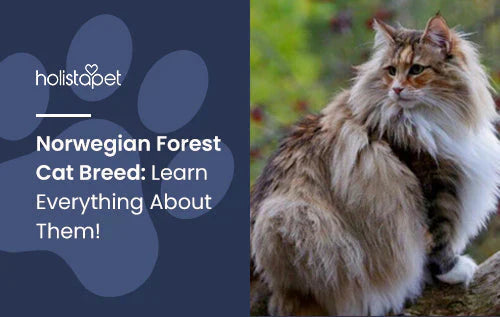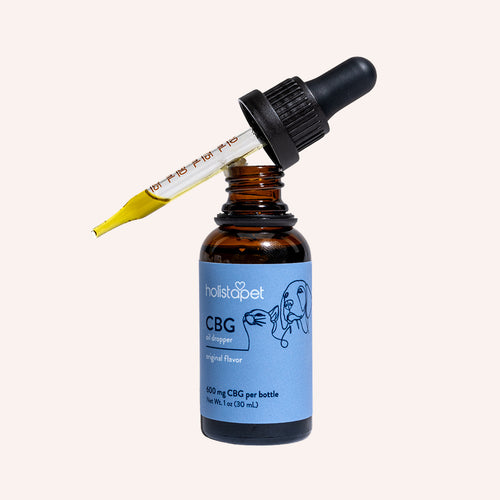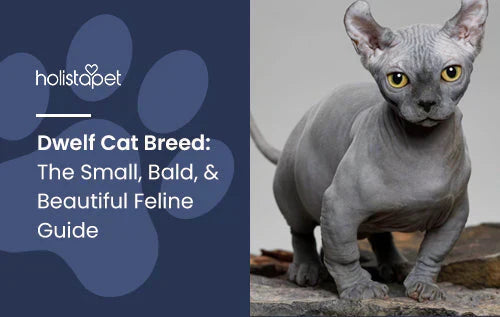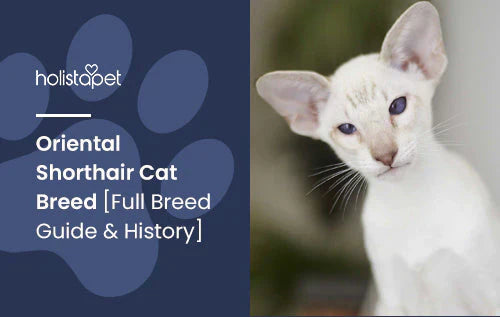The Norwegian Forest Cat, often called Wegies by their many fans, is quickly growing in popularity nationwide. This is thanks to their long, thick coat and irresistibly independent attitude. The Norwegian cat has unique adaptations to its cold environment, tracing its ancestry to various longhaired cats brought by the Vikings and Crusaders. Historically significant, it served as a ship's cat and has been recognized as an official breed in multiple countries.
There’s nothing more appealing than a big, beautiful cat that doesn’t need you — but still chooses to be around you to get some much-needed snuggling and head scratches! This large breed might be for you if you love a cat with curiosity and don’t mind some extra shedding.
Breed Origin & History
The Norwegian Forest Cat is a newer breed in the United States. But it’s been around for quite some time in Norway, known as “Skogkatt,” which translates to “forest cat.” They have been featured in folk tales and mythology for centuries, and it’s thought that Wegies often accompanied Vikings to take care of rodents on the ships. It’s possible that someone like Leif Erickson was the first to bring the Norwegian Forest Cat to North America in the late 900s.
The Wegie was almost lost as a distinct breed for a while as the big cats continued to mate with domestic shorthair strays throughout Norway. But their human admirers didn’t want to see them disappear for good. The Norwegian Forest Cat was exhibited at the Oslo Cat Show in 1939, but World War II put the breed revitalization plans on hold. The Norwegian Forest Cat Club was established in 1938 and was crucial in developing an official breeding program, significantly contributing to the breed's resurgence in Norway.
When World War II ended, the focus was back on the Wedgie. Cat enthusiasts started to show off the breed around Europe. The late King Olaf appointed it the official cat of Norway. In 1977, Europe’s Federation Internationale Feline recognized the Norwegian Forest Cat as an official breed. Two years later, the Wegie was the first cat owner to export to the United States, and Americans immediately fell in love with the big feline. In 1987, the breed was presented to the Cat Fanciers Association, which gave the breed full champion status in 1993.

Cat Breed Personality
While they’re typically friendly and laid-back, this cat t is known to be very independent. Their personality is characterized by being gentle, friendly, playful, and sociable while also valuing independence. Although they do enjoy human companionship, they are content with just relaxing in a window bed or staring out a window—on their terms. They’ll curl up on your lap, but only if they like it! And they’ll leave when they feel like it, too. Wedgies love a good head scratch and show appreciation with head bonks.
This cat is also a bit territorial. Because of this, it needs to have a home to call its own. Known for climbing everything in the house, a ceiling-high cat tree can give it the space it needs to feel secure and content. It loves heights and has even been known to climb down cat trees headfirst without any fear.
The Wegie is also moderately active and is known to have random bursts of energy. They can entertain themselves with toys, running, hiding, and then ambushing them like prey. When they get tired, they’ll either sleep atop their cat tree or curl up next to you on the couch for snuggles. When you invite someone new to your family life at home, this cat may initially be a bit reserved. They often need time to get used to new faces, but they’ll be friendly and curious once they’re more comfortable with their presence.
Related: CBD for Cat Anxiety - How to Calm with Cannabinoid
Cat Breed Characteristics (Physical)
The Norwegian Cat is often compared to the Maine Coon because they are also large and fluffy. However, the cat's size is slightly smaller than the Maine Coon, yet still impressive. The Cat Fanciers’ Association has identified many distinctive traits unique to this majestic breed. Their eyes, expression, and face shape set them apart from other cat breeds, as does their glorious double coat.
Norwegian Forest Size
The Norwegian Forest Cat's size is notable, as they won’t reach maturity until they’re five. But your cat could be anywhere from 13 to 22 pounds by that age. The Wegie has a long and sturdy body, defined by solid muscles and a broad chest. The CFA describes them as “powerful” in their wild, rugged appearance and “large and imposing.” Their tail is also broad, notably long and bushy.
Head
This cats' facial features are what set them apart from the Maine Coon, Ragdoll, and other larger breeds. Upon their short and heavily muscled neck, the Wegie has an alert and proportionate head with large eyes, a firm and rounded chin, and ears with rounded tips. Lynx tips are desirable, although not required by the CFA.
Eye color
The Wegie's eyes are large, almond-shaped, expressive, and open. The cat's eyes should be shades of green, gold, green-gold, and copper. Norwegian Forest cats with white fur may have blue eyes. White-colored Wedgies are even known to have odd eyes, where one eye could be blue, and the other might be another color!

Legs & Paws
It's no surprise that the cat has straight and muscular legs. This breed typically has hind legs that are longer than their front. The CFA describes their paws as "toe-out." Their paws are large and round, with heavy tufting between each toe.
Coat
Insulated and waterproof, the cat's double coat was originally how this hearty breed withstood Scandinavian winters in Norway. They have long, coarse guard hairs and a dense undercoat. They deal with harsher weather and environments thanks to their ruff, bushy tail, fluffy back legs, and "bib" of fur, along with their tufted paws. Norwegian Forest Cats often have a brown and white tabby patterned coat, but they can come in most colors — from pure white to dark black — and every coat pattern.
Cat Care
While the Wegie has quite an impressive coat, it surprisingly doesn’t need much coat maintenance. The CFA recommends weekly brushing. Some Norwegian Forest Cat owners will tell you that they brush twice weekly with a bristle, slicker brush, or stainless steel comb. This helps remove tangles, reduce shedding, and help your Wegie avoid hairballs.
It is essential to teach this cat kitten that grooming is a bonding experience. This eases the process since these kittens have a thick coat that requires regular maintenance to prevent matting. Luckily, don’t need to be bathed too often. But if they ever need that extra cleaning, remember that their coats are very waterproof, making it nearly impossible to get them wet enough!
Brushing your cat’s teeth weekly — or daily, if possible —will avoid periodontal disease. It would be best if you also wiped the corners of their eyes daily with a damp cloth to remove any discharge you see. Remember to use a different part of the washcloth for each eye to avoid a potential infection spread. Check the Norwegian’s ears weekly to ensure no wax or dirt buildup. Use cider vinegar and warm water on a cotton ball to lightly wipe them out if they look dirty.
While this cat were bred to endure cold weather and harsh climates, you should consider keeping your kitty indoors. This will protect them from diseases spread by other cats, like FIV, and keep them safe from dogs, coyotes, and cars. Since your Wegie will be significant and beautiful, it may even be catnapped by others.
Health Problems
Norwegian Forest Cats can live 12 to 16 years on average if they’re given adequate care. Always ensure you’re adopting from a reputable breeder who offers health guarantees on kittens. When adopting Norwegian Cat kittens, it is crucial to choose a reputable breeder to ensure the kittens are healthy and to be aware of potential health considerations. It should be noted that a few hereditary diseases are more common in Wegies than other ailments.

One is hypertrophic cardiomyopathy, a common heart disease found in cats. The heart muscles in lap cats will thicken, causing them not to pump blood as effectively. While it seems to happen without cause, you’ll notice your Wegie is lethargic or has leg swelling. If you see any concerning signs of hypertrophic cardiomyopathy, make an appointment with your vet.
Hip dysplasia is also common in cats. It’s a defect of the hip socket that can eventually lead to severe lameness and joint discomfort if left untreated. You’ll notice your blue Norwegian Forest Cat moving slowly or avoiding jumping. If your Wegie is not trying to climb on almost everything in your house, you might want to bring them in for a checkup.
Related: What Can I Give My Cat for Pain Relief?
Nutrition
While Norwegian Forest Cats are pretty large, they shouldn't be obese. Like all cats, they should be fed the recommended serving size for their weight each day. So, this might be a bit more than the average cat. Cat treats should consist of healthy ingredients and be fed to your cat at a rate of no more than 10% of daily food intake. You can add beneficial additives, like CBD oil, to boost their nutrition to cats' diets.
The commercial cat food you pick should have a named protein source, like chicken or salmon, and the proper amount of taurine. Cats need This essential amino acid to remain healthy and active. You may even want to consider cat food formulated for hairballs or digestion due to the Wegies' thick coat. This cats have been known to regulate their intake, cutting down on food or increasing their exercise if they feel it's necessary.
Children & Other Pets
Norwegian Forest Cats are not a needy breed. They're known to be quite independent, so a feline companion is not required. However, if you prefer multiple cats, the Wegie is easygoing and can learn to share their space. Just make sure they have a space to call their own. This can be somewhere off the ground so they don't feel insecure.
Because of Norwegian forest cat size and temperament, this cats are great playmates for dogs. They are an adaptable breed that often goes with the flow, meaning they won't get too bothered by a dog's antics. They are also happy to interact with children, although you should always make sure you're there to supervise to avoid tail pulling or playful scratching. Kids will love watching a big Wegie jump out from behind a corner and bound toward a toy.
More About This Cat Breed
The origin of this cat a mystery. Some say they are descendants of Siberian cats found in Russia. Others say they are just cats who adapted to the Arctic through natural selection. The mystery of the Wegie is nothing new. There are Norwegian legends and myths about a long-haired “mountain-dwelling fairy cat” that climbed trees and rocks with ease.

Compared to Maine Coon cats, Norwegian Forest Cats are generally similar in size but have distinct differences in appearance and specific characteristics such as tail length and eye shape. This cat, known as the “skogkatt,” was a favorite of Freya, the Norse goddess of love and beauty. The Wegie is also found in a Norwegian tale about Thor, who loses a strength contest to the tricky god Jormungand while disguised as a skogkatt.
So, by now, you probably can tell that the Wegie is known for its size and giant coat. But some people are shocked that young Norwegian Forest Cats won’t get their infamous fluff until they’re two years old. They won’t even have their recognizable adult coat until they are three months old, meaning you may start with a short-haired kitten!
Do you think a Norwegian Forest Cat is the right fit for your family? A Wegie may set you back about $1,500. But the hefty price tag is worth it if you’re looking for a big, fluffy cat to rule your home from the highest perch in the building. See this site.


 CBD Oil for Cats - Fast Acting
CBD Oil for Cats - Fast Acting
 CBD Cat Treats - Easy Dose
CBD Cat Treats - Easy Dose
 CBD Calming Chews for Cats - Highly Rated
CBD Calming Chews for Cats - Highly Rated
 CBG Oil for Dogs and Cats - Loved by Thousands
CBG Oil for Dogs and Cats - Loved by Thousands





Leave a comment
All comments are moderated before being published.
This site is protected by hCaptcha and the hCaptcha Privacy Policy and Terms of Service apply.